Through interviewing the curators of the Amherstburg Freedom Museum, Dr. Mary-Katherine Whelan and Dr. Lorene Bridgen-Lennie, we learn that preserving and showcasing sites of memory to the public is an essential task in order for narratives of the past to not fade into obscurity. Throughout the discussion, we mention Henry Bibb, a prevalent abolitionist within the area, as well as others like Mary Bibb and Mary Ann Shadd who served just as important roles in the community. The value of narratives, such as Bibb’s, as sites of memory, is also explored. Additionally, we briefly discuss the reliability of these narratives as many people do embellish parts of their stories to create more engaging sequences. Our main goal throughout this project has been to showcase the value of sites of memory and to shift the American- orientated narrative to a Canadian one. This project showcases the collaborative efforts of Danielle Walls, Yosef Warder, and Hayden King.
Interview with the Amherstburg Freedom Museum
Narrative of the Life and Adventures of Henry Bibb
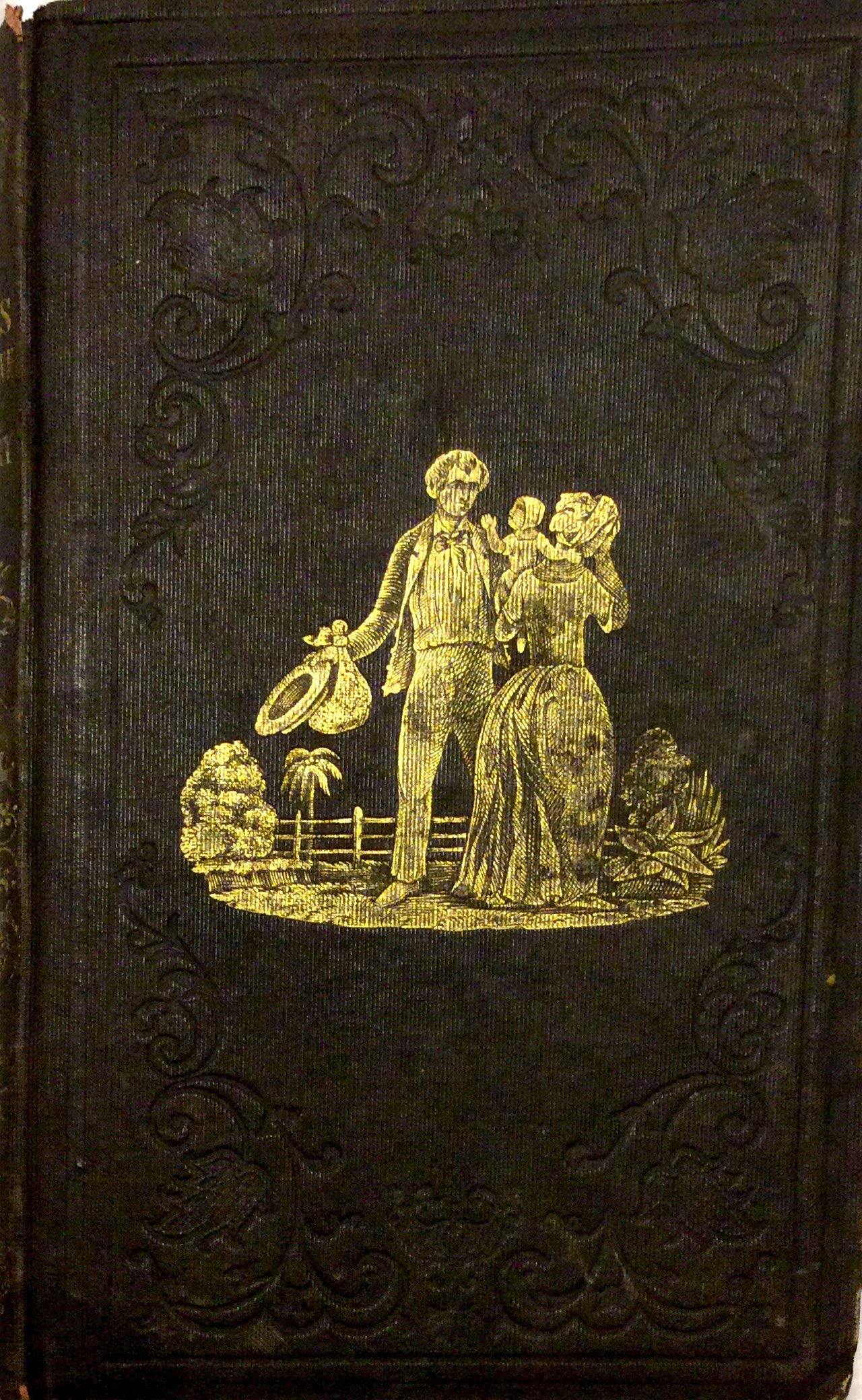
Cover Depicting Henry Bibb and His Family
Henry Bibb was born on May 10, 1815, in Cantalonia, Kentucky. In 1833, he would marry another slave named Malinda with whom he had a daughter, Mary Frances. The cover of Bibb’s narrative depicts the family together. This is before the unfortunate separation of Bibb from Malinda due to her being sold to a plantation owner. After this, Bibb went to Detroit where he would lecture about abolition and join the anti-slavery movement. In 1848, he would marry another abolitionist by the name of Mary Elizabeth Miles (Bibb). The following year, Bibb would go on to publish Narrative of the Life and Adventures of Henry Bibb (this book). They would later settle in Sandwich, Upper Canada where Bibb would publish the first black newspaper in Canada, The Voice of the Fugitive in 1851. Bibb would continue his abolitionist work until his death on August 1, 1854. The usage of this picture shows how much Bibb valued his original family and ow he never forgot them despite never seeing each other again. That particular narrative was a reality for many enslaved families during this period, and Bibb using this picture shows that this event deeply impacted him and influenced his abolitionist work thereafter.
Condition
The condition of Narrative of the Life and Adventures of Henry Bibb is in, overall, excellent condition. With the exception of a few water spots and stains on the pages, the text is intact and the front and back covers remain in amazing condition. This is impressive for a book initially published in 1849. The condition of this narrative shows the value and care that was placed on it by the former owners as well as the Western University archives.
First page of Chapter 1
In the first chapter of Narrative of the Life and Times of Henry Bibb. He was born May 1815 to a slave mother. when the Partus sequitur ventrem law came out, all children of slave mothers would become slaves.
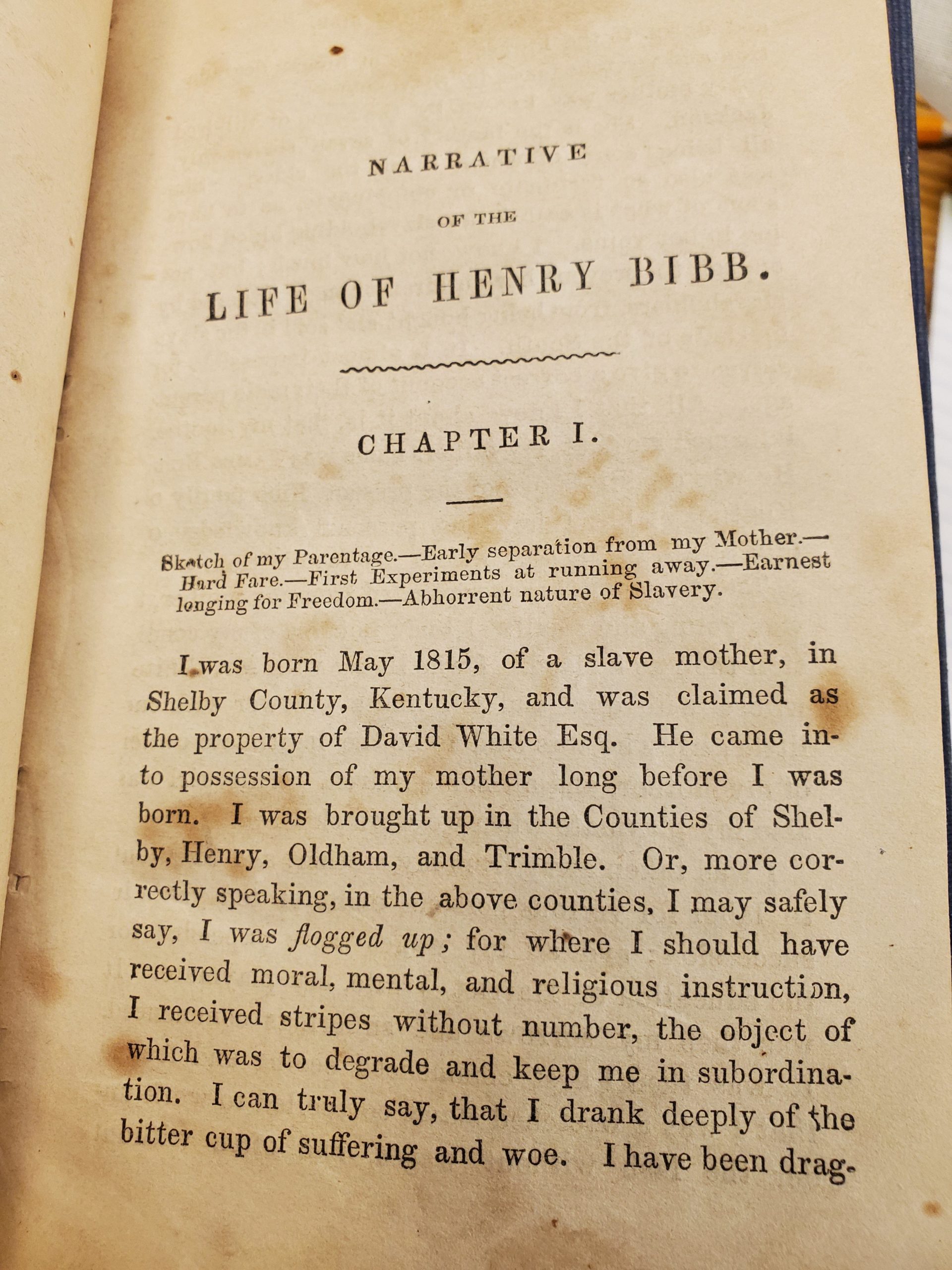
In the first chapter of Narrative of the Life and Times of Henry Bibb. He was born May 1815 to a slave mother. when the Partus sequitur ventrem law was passed, all children of slave mothers would become slaves.
Henry After Being Captured
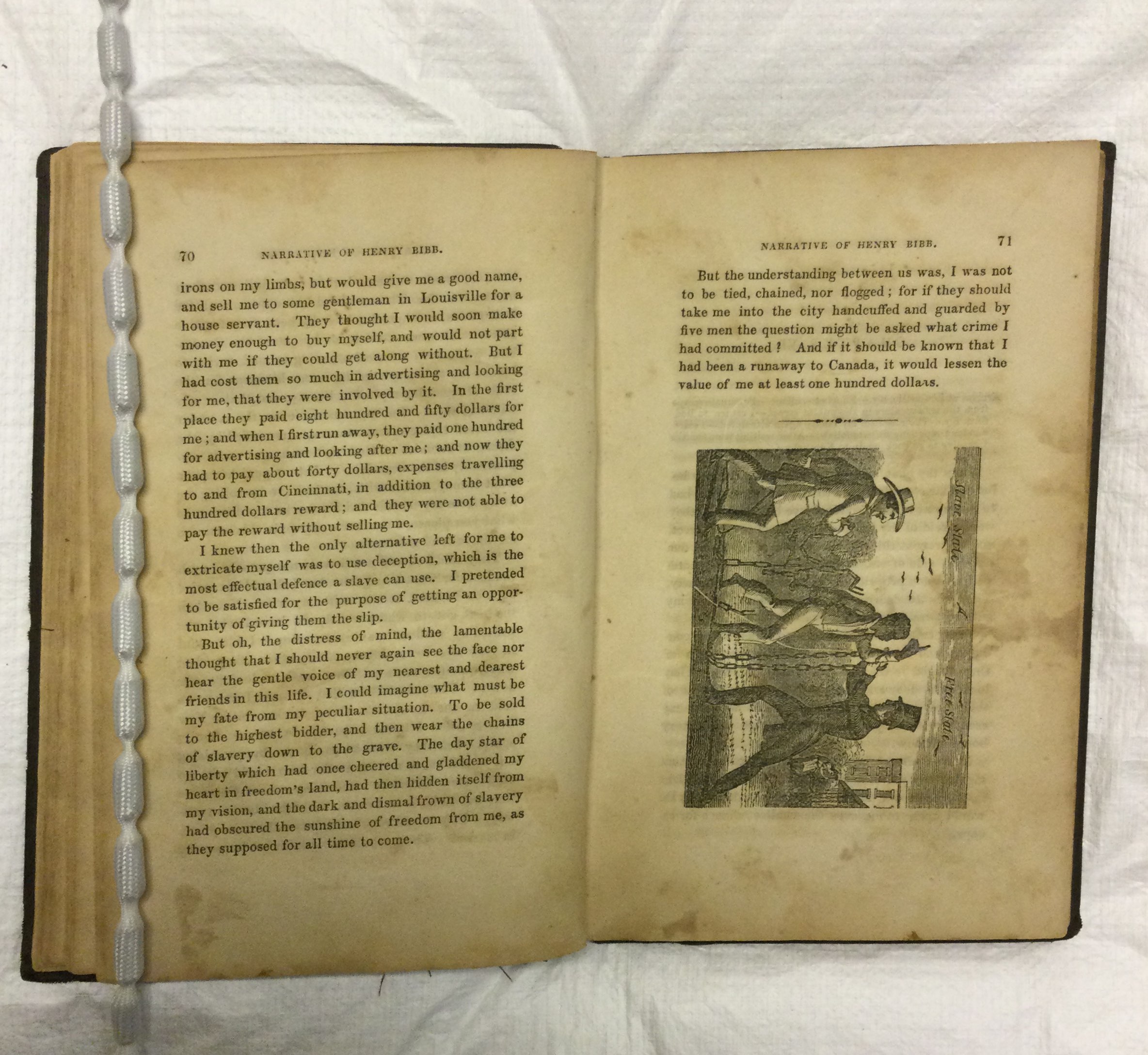
Henry with Slave Hunters
The photo on page 71 displays Henry Bibb shackled with a slave hunter on either side of him. Henry had recently escaped and been captured. His whereabouts had been exposed by two black men in Cincinnati. Who then told the slave hunters where he was located. After being captured, the slave hunters promised to buy Henry out of slavery if he were to expose where other escaped slaves were. These slave-hunters had paid so much in the search for Henry that they were desperate to recoup their costs by selling him and using potential information he knew to capture other slaves.
It’s interesting to see how a career could be made just by tracking down escaped slaves, it surely would have been a lucrative career as well. The men who captured Henry had spent hundreds of dollars through advertising and travel expenses, which was a huge amount of money at the time.
Fighting Off Wolves
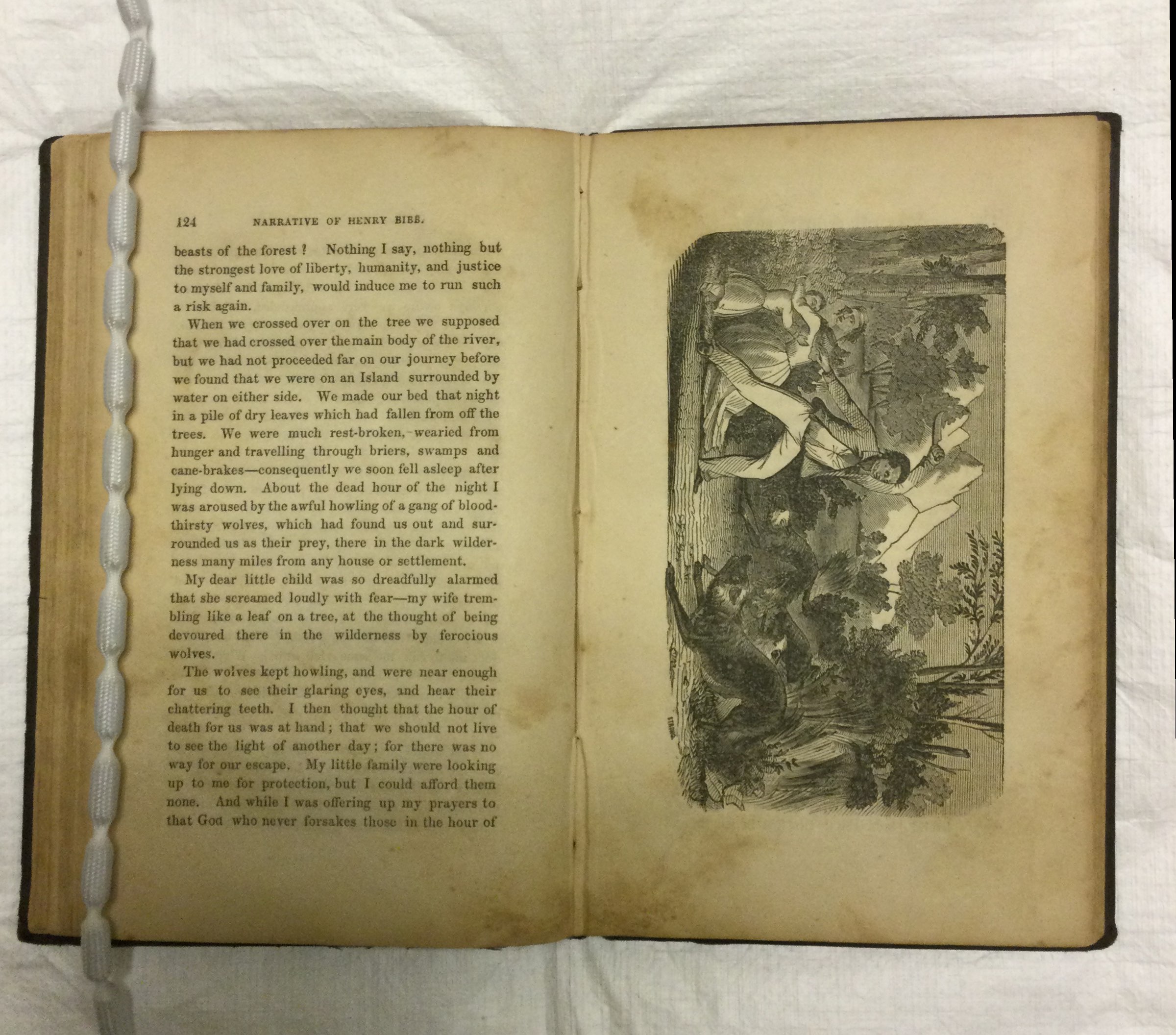
Bibb Fighting Off Wolves
This is a drawing on page 125 depicting Henry Bibb fighting off wolves that are surrounding his wife and daughter. By including this sketch, It shows the hardships and the lengths that enslaved individuals would go through in order to escape their enslavement.
Throughout Bibb’s narrative, he laments about his daughter, Mary Frances, and how frightened she is and how he cares for her. This passage and picture clearly show how much fear Bibb held for his family, and with us as readers knowing that they will never see each other again, it hurts all the more. However, Bibb wrote this after the separation, so we need to acknowledge that parts of the narrative may be embellished due to heavy emotions and trauma. This is not to discredit the passages, but to analyze them within an emotional as well as historical context.
Fleeing From Slave Hunters
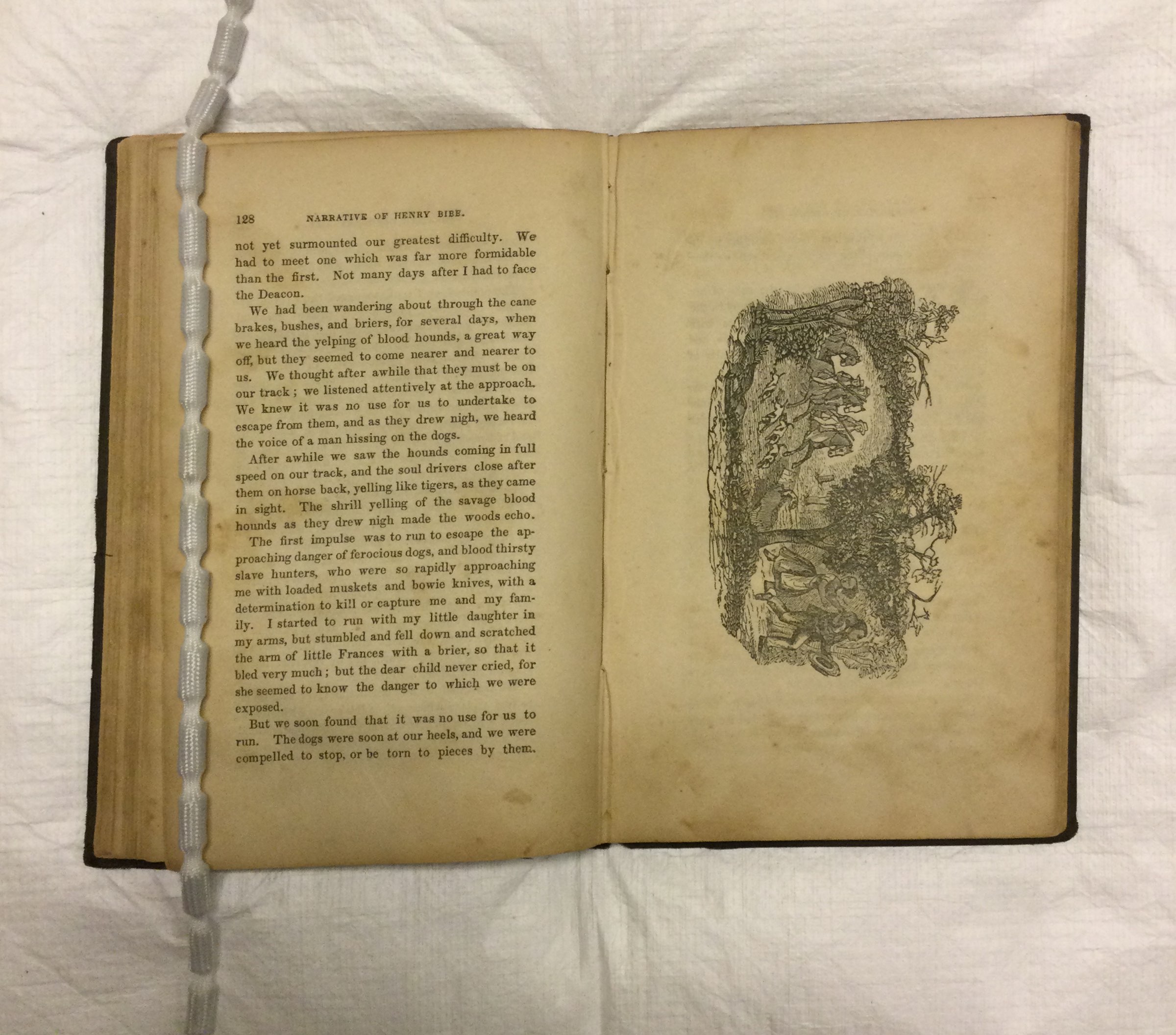
Fleeing From Slave Hunters
This picture on page 129 shows Bibb and his family fleeing from slave hunters and their bloodhounds. The passage beside it on page 128 describes the Bibb’s running away from the hunters just after the wolf attack as mentioned previously on page 125.
This was a reality for many individuals fleeing enslavement and the fear and chaos surrounding it. The picture shows the hunters on horseback holding rifles with the dogs running ahead of them. This invokes images of fox or deer hunts that occurred as sport. The angling of the picture with the family in front and the hunters chasing after them in a line-formation is militaristic and creates a sense of dread and anxiety for the reader. It exemplifies the emotions and memories of Bibb when he was running and allows the reader a glimpse of his memories in the form of a sketch.
Henry Bibb Receiving a Lashing
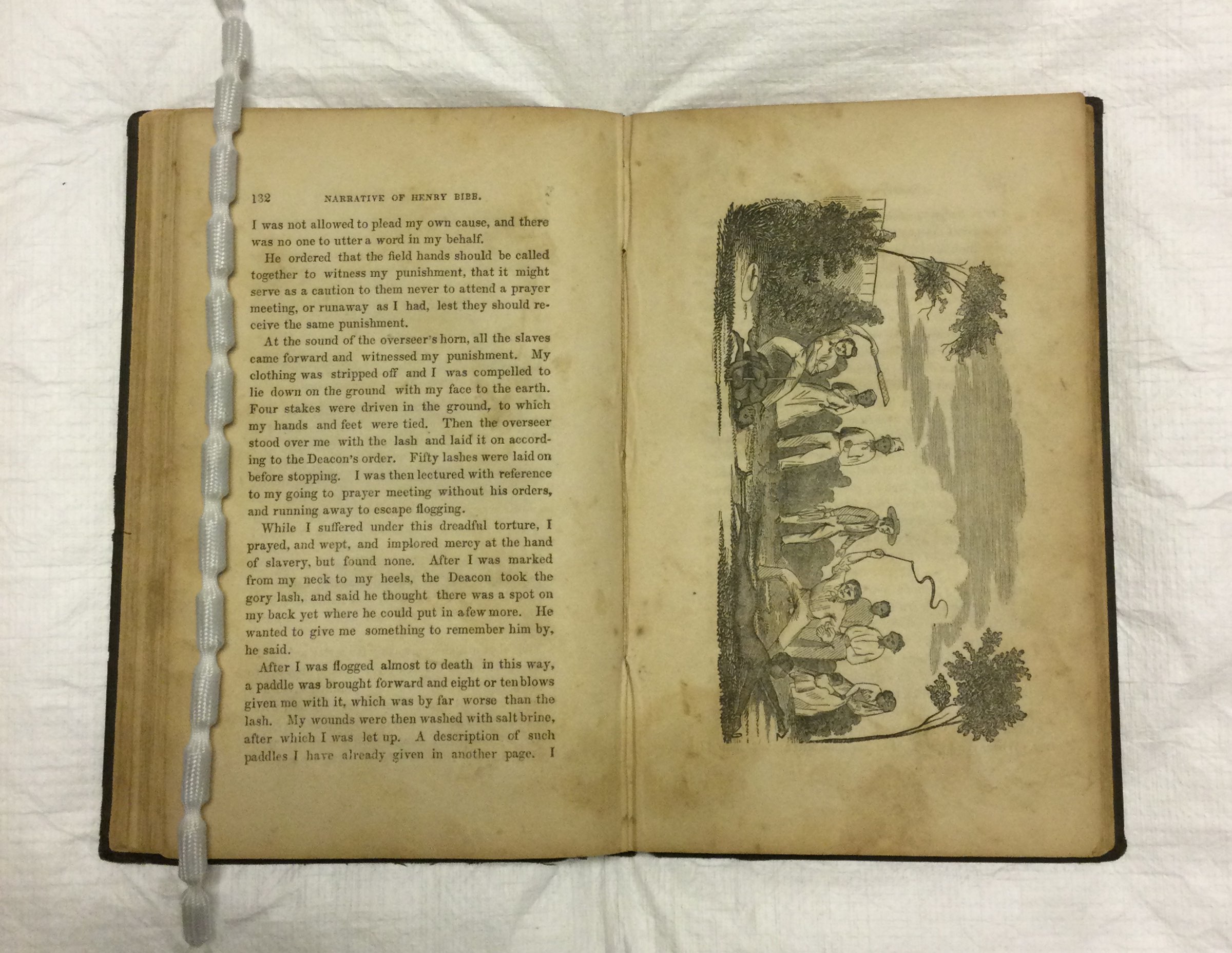
Henry Bibb Receiving Lashings
This drawing on page 133 depicts Henry Bibb bound after being caught escaping his cotton plantation and receiving lashings. The man lashing Henry Bibb is the plantation overseer. The man in the hat is presumably Deacon Whitfield. Whitfield ordered for all of the slaves to gather around to create a specimen of escapees, and slaves who went to pray without permission, Henry had only committed the former. Henry was forced to lay face down and was stripped of his clothing, each limb was then tied to a stake. Bibbs had received fifty lashes before Whitfield stopped commanding the overseer to lay them. After the lashings Whitfield had said that there was an area of Bibb’s back that more marks could fit in, he was then paddled. After receiving these blows Bibb was washed in salt brine.
The inclusion of this image provided a graphic insight into the life of a slave, something that was rare and limited by first-hand accounts and drawings.
Bibliography
Amherstburg Freedom Museum. “Home.” Accessed November 30, 2020.
Bibb, Henry. Narrative of the Life and Adventures of Henry Bibb an American Slave. Henry Bibb, 1849
Canada’s Historic Places “Nazrey African Methodist Episcopal Church National Historic Site of Canada.” HistoricPlaces.ca – HistoricPlaces.ca, Canada’s Historic Places, 4 May 1999, www.historicplaces.ca/en/rep-reg/place-lieu.aspx?id=6054.
Cooper, Afua P. Black Women and Work in Nineteenth Century Canada West: Black Woman Teacher Mary Bibb. University of Toronto Press, 1999.
Cooper, Afua. My Name Is Henry Bibb: a Story of Slavery and Freedom. Kids Can Press, 2010.
Finley, James. “The Land of Liberty”: Henry Bibb’s Free Soil Geographies.” ESQ: A Journal of the American Renaissance 59, no. 2 (2013): 231-261.
Landon, Fred. “Henry Bibb, a Colonizer.” The Journal of Negro History, vol. 5, no. 4, 1920, pp. 437–447. JSTOR, www.jstor.org/stable/2713678. Accessed 30 Oct. 2020.
Lewis, Amy. “Who’ll Speak for Malinda?: Alternate Narratives of Freedom in The Life and Adventures of Henry Bibb.” African American Review 52, no. 3 (2019): 255-276.
O’Farrell, John K. A. “Biography – BIBB, HENRY WALTON – Volume VIII (1851-1860) – Dictionary of Canadian Biography.” Home – Dictionary of Canadian Biography, University of Toronto/Université Laval, 2003, www.biographi.ca/en/bio.php?id_nbr=3786.
Ontario Heritage Trust. “Black Settlement in Ontario.” Accessed October 28, 2020. https://www.heritagetrust.on.ca/en/pages/our-stories/slavery-to-freedom/history/black- settlement-in-ontario.
Parris, Amanda. How Much Do You Know About Black History in Canada?. Toronto: Canadian Broadcasting Corporation, 2017. 50:18. https://curio-ca.proxy1.lib.uwo.ca/en/video/how- much-do-you-know-about-black-history-in-canada-15292/.
Windsor Public Library. “Henry Bibb.” Accessed December 3, 2020. https://windsorpubliclibrary.com/?page_id=62473.